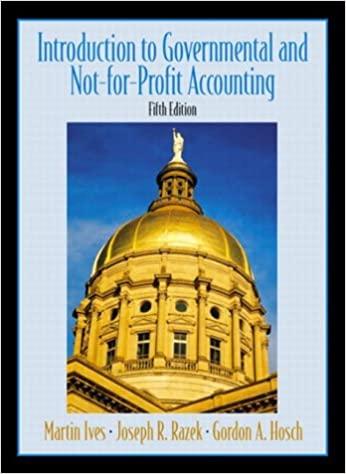(Allowance for uncollectible property taxes-allowance method) The City of Aldwich uses the allowance method of handling uncollectible...
Question:
(Allowance for uncollectible property taxes-allowance method)
The City of Aldwich uses the allowance method of handling uncollectible property taxes. In FY 2004, the following transactions took place:
1. At the end of FY 2003, property taxes receivable were $\$ 10,000$. The allowance for uncollectible property taxes was $\$ 3,000$.
2. In FY 2004, collections of FY 2003 property taxes were $\$ 5,000$ from J. Bond and $\$ 3,000$ from J. Steed. J. Tebbe, who owed $\$ 2,000$, was unable to pay his property taxes. The account was written off.
3. During FY 2004, property taxes of $\$ 50,000$ were levied. An allowance for uncollectible property taxes of 6 percent was established for this particular tax levy. The property taxes were levied as follows:

4. Bond and Steed paid their FY 2004 property taxes in full and on time.
5. King refused to pay his FY 2004 property taxes. As a result, a lien was placed against his property. Costs of processing the lien amounted to $\$ 200$. Shortly thereafter, his property was seized and sold for $\$ 30,000$. Costs of the sale were $\$ 2,000$. After the appropriate deductions had been made, a check for the balance of the sale price of the property was sent to King.
6. E. Peel was unable to pay her taxes. Because her property was not salable, the account was written off without further legal action.
7. At the end of FY 2004, S. Templar had not paid his property taxes. The Templar account was reclassified as delinquent.
8. In FY 2005, the city established an allowance for uncollectible property taxes of $\$ 15,000$ and an allowance for property tax refunds of $\$ 20,000$. The FY 2005 property taxes were levied as follows:

9. J. Steed appealed his tax assessment, and his levy was lowered to $\$ 20,000$.
10. In FY 2005, S. Templar paid his FY 2004 property taxes. He was, however, unable to pay his FY 2005 property taxes. Therefore, the account was written off.
11. Other collections during FY 2005 were

12. J. Bergerac was unable to pay his property taxes. The account was written off because of Bergerac's adverse situation.
The city identifies receivables by year and by taxpayer (e.g., Property taxes receivable-FY 2004-Bond, $\$ 10,000$ ); and it identifies the allowance for uncollectible property taxes by year (e.g., Allowance for uncollectible property taxes-FY 2004).
Required: Prepare entries to record (in chronological order):
1. The setting up of the FY 2004 and the FY 2005 receivable (and allowances for uncollectible property taxes and for property tax refunds)
2. The collection of property taxes in each year.
3. The writing off of uncollectible accounts and property tax refunds 4. The treatment of the prior-year allowance for uncollectible property taxes in FY 2004 and FY 2005 5. The lien against, seizure, and sale of the King property
Step by Step Answer:

Introduction To Government And Not For Profit Accounting
ISBN: 9780130464149
5th Edition
Authors: Martin Ives, Joseph R. Razek, Gordon A. Hosch





